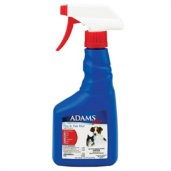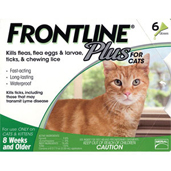Cat owners have been battling with
fleas and ticks for as long as cats and people have been living together.
These parasites are in so many environments that even pets that rarely
leave the home should be considered at potential risk for picking up fleas,
and to a lesser extent, ticks. Thankfully, controlling these nasty
parasites has never been easier.
"Flea and tick bites can also transmit very serious diseases from one animal to another."
Why Should Pet Owners Be Concerned About Fleas?
Fleas and ticks are not just a nuisance.
A flea-infested cat may scratch and bite herself until she is bald over
large parts of her body. Flea bite allergies can cause even more
severe skin lesions. When a large number of fleas are present,
they suck a lot of blood from the body, and particularly if the pet
is very small or young, a potentially life-threatening anemia may develop.
Flea and tick bites can also transmit very serious diseases from one
animal to another.
How Do I Know If My Pet Has Fleas Or Ticks?

Owners should examine their cats on
a regular basis. Use your hands to part the fur so you can see
directly down to the skin. Look over the cat's whole body, but
pay special attention to the area around the base of the tail, back
of the hind legs, around the face and in the armpits and groin.
Here are some things to watch out for.
Fleas are smaller than a
grain of rice. They have a body that is taller than it is wide
and can move very quickly, often dashing across the skin or leaping
away when disturbed. Flea feces, also called flea dirt, looks
like coffee grounds and is often visible even when fleas are not.
Cats may groom themselves so fastidiously that they remove much of the
evidence of a flea infestation. If your cat is itchy, fleas are
still a strong possibility even if you don't see them on your pet.
Most ticks are significantly
larger than fleas, although some species and immature ticks can be quite
small. They are often found with their mouthparts firmly embedded
in the skin. A tick that has fed on blood will look like a plump
bean, rather than having the relatively flat appearance of a tick that
has not yet eaten.
Flea Treatments at Home
If you find ticks on your cat, they
need to be removed. Use a pair of tweezers or tick pliers to firmly grasp the tick as close to the skin
as possible and pull with steady pressure. Flush the tick down
the toilet and wash your equipment and hands immediately.

Cats that have fleas or many ticks
on them require a more generalized approach. Sprays, shampoos and dips are all useful, but they don't do much to
prevent the parasites from coming back in the future. The best
way to keep fleas and ticks off of your cat for a month or more is to
use a topical preventative like Advantage II or PetArmor. If your problem is limited to fleas only, Capstar and Program are all good choices. Revolution and Advantage Multi can help with fleas,
heartworms, and other parasites as well. Collars that claim to
control both fleas and ticks are not as effective as some of the other
choices now available to cat owners.
Fleas can quickly start breeding inside
the home and move from pet to pet, so all animals in a household need
to be treated. Vacuuming carpets, floors, and upholstery and washing
pet bedding is very helpful and usually sufficient if an effective flea
control preventative is also used monthly. If more environmental
control is necessary premise
and yard sprays and foggers are available.
Whatever type of flea and tick control
you choose, carefully follow the manufacturer's directions to maximize
its effectiveness and safety. Cats are extremely sensitive to
some of the chemicals used to treat parasites. Never use a product
that does not clearly state that is safe for cats on or around these
animals.
Veterinary Care for Fleas & Ticks
Your veterinarian can help you determine
which flea and tick control product is right for your cat. If
your pet has an especially severe infestation, or is acting sick in
any way, bring her in for an exam.
The above is provided for information purposes only and should not be used for the diagnosis or treatment of any condition.
This information does not cover all possible variables, conditions, reactions, or risks relating to any topic, medication, or product and should not
be considered complete. Certain products or medications may have risks and you should always consult your local veterinarian concerning the treatment of
your pet. Any trademarks are the property of their respective owners.